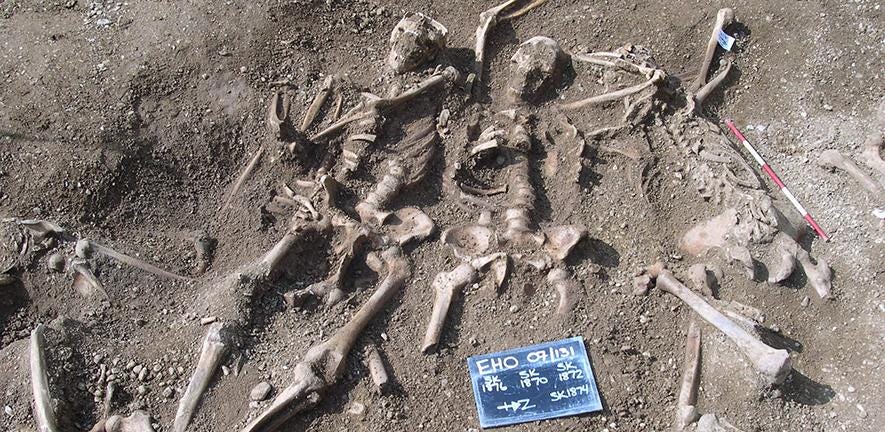Live like a Viking and you'll grow worms, not muscles
We indulge in rubbish, but at least it's sterile.
The Northmen weren’t exactly guzzling fizzy drinks or snacking on ready meals. Their diet was surprisingly decent—protein-packed and relatively balanced when stacked up against most of medieval Europe. They kept active too, either toiling away on the farm or paddling halfway across the world on their longships. No choking on coal-smog either. And believe it or not, they actually cared about grooming, using combs and tweezers to keep themselves somewhat presentable. So they were healthier than we are today!
Intestinal guests
Well...no. Absolutely not. Living in the Viking Age would’ve sometimes been a full-blown biological horror show.
One reason: parasites. Loads of them. Not just the scratchy nuisances like lice and ticks, but the proper nightmare-fuel sort—the ones wriggling about inside your guts. A recent study has revealed that the Vikings were riddled with intestinal parasites. Researchers examined ancient turd (a great archaeological source!) and found eggs from these unwanted guests, proving that both people and their livestock were teeming with them. Unsurprising, really, when you consider that humans and animals were often crammed together in less-than-sanitary living spaces.
What’s rather thrilling—for archaeologists, at least—is that these ancient parasite eggs can be identified down to the species. That tells us what health issues plagued the Vikings and what animals they kept where. This discovery is part of a sweeping Danish-led project delving into the evolutionary, demographic, and health narratives of humans from prehistoric times to today.
In this particular study, soil samples from a Viking settlement near Viborg were analysed—specifically, the contents of a latrine used between 1018 and 1030. After carefully separating the parasite eggs from the soil, scientists extracted and sequenced their DNA. This allowed them to figure out not just what parasites were present, but whether they were infecting humans. The results were grim: the soil contained eggs from roundworms and whipworms that target humans, as well as liver fluke, which affects cattle and sheep. While eggs alone don’t tell you the host, DNA sequencing leaves no room for doubt—these parasites were absolutely freeloading off the Vikings.
In fact, this type of analysis opens up exciting possibilities for tracing human migration. Because parasites hitched rides with humans across the globe, their genetic markers show us where people went and when. Many of these worms likely originated in Africa, travelling alongside us as we spread across continents. By comparing parasite populations over time and space, we get a clearer map of human history than we ever could from bones alone.
Had you lived in the Viking Age, you’d have likely spent time doubled over in pain from these infections—nausea, diarrhoea, abdominal cramps, vomiting, weight loss. Tapeworms were particularly fond of the Norse gut and remained a European nuisance until well into the 20th century. The Norse were especially vulnerable due to their fondness for raw or undercooked fish and pork—prime tapeworm delivery vehicles.
In mild cases, a tapeworm might just make you uncomfortable. In more serious ones? Blood loss, seizures, and lasting internal damage. Fish tapeworms could drain you like a leech, while pork tapeworms might crawl into your brain and cause neurological issues. Their high prevalence paints a vivid picture: undercooked meat was clearly a regular feature on the Viking menu.
The parasite problem wasn’t exclusive to Scandinavia, either. Sites from as early as 500 BCE in Bahrain and as late as 19th-century Netherlands show widespread infections by nasties like the giant roundworm and whipworm. Clearly, our intestinal hitchhikers have enjoyed a long and cosmopolitan history. The Viborg study even turned up parasite DNA from animals—sheep, pigs, horses, dogs, rats—you name it. It’s further proof that Viking homes were shared by a motley crew of humans and beasts, creating the perfect storm for interspecies infection.
Even more astonishing, the researchers found traces of fin whale and deer DNA—evidence the Vikings were hunting and eating them. Add to that the presence of tapeworms well into the 1800s, and it’s clear these parasites were not just a blip in the historical health record. By examining parasite DNA from different times and places, scientists can also piece together what people were eating. In 17th-century Denmark, for example, diets were heavy on cod and pork—again tying neatly into known tapeworm outbreaks. It’s like ancient MasterChef, with a side of biohazards.
Strangely enough, those filthy Viking loos may have contributed to respiratory issues still seen in Scandinavians today. In an evolutionary twist, long exposure to intestinal worms may have altered Viking genetics in ways that backfire in the modern world. Take the molecule alpha-1-antitrypsin (A1AT): it’s our body’s natural shield against inflammation-causing enzymes. The Vikings developed mutant versions of A1AT to fend off worm enzymes—but without the regular version, their bodies were left vulnerable to their own immune system’s attacks.
In today’s cleaner, worm-free environment, those same genetic tweaks can cause serious lung issues. A1AT deficiency is now the only known inherited risk factor for chronic lung diseases like emphysema and COPD. Thanks to smoking and longer lifespans, what once helped Vikings survive now leaves some modern Scandinavians gasping for air. It’s a sobering example of an evolutionary trade-off. Just as the sickle-cell trait once protected people from malaria at the cost of triggering sickle-cell disease, these Viking-era defences now undermine our respiratory health.
An axe may not kill you, but a virus will
And just when you thought it couldn’t get any worse—enter smallpox.
Yes, the Vikings had that too. Scientists recently discovered extinct strains of the smallpox virus in Viking skeletons, proving for the first time that this deadly scourge was around at least 1400 years ago. Much like COVID-19, smallpox likely spread via global travel—and the Vikings, notorious seafarers, were ideal vectors.
The variola virus, which causes smallpox, was vicious: it spread via airborne droplets, killed a third of those infected, and left another third disfigured or blind. It wiped out an estimated 300 million people in the 20th century before being eradicated in 1980—humanity’s first successful battle against a virus.
A study published in Science by an international team, including researchers from Cambridge and Copenhagen, sequenced ancient strains of smallpox from Viking remains. They unearthed traces of the virus at eleven burial sites in Denmark, Norway, Russia, and the UK—plus Öland, a Swedish island known for its trade networks. That’s a whole lot of virus for one era. They managed to reconstruct near-complete genomes of these ancient strains, revealing they were genetically distinct from the 20th-century killer variants. This helps virologists understand how deadly pathogens mutate over time, becoming either milder or much, much worse.
Historians had long speculated that smallpox existed as far back as 10,000 BC, but until now, proof was lacking. Turns out the Vikings were infected, too—providing concrete evidence that epidemic outbreaks were a threat far earlier than anyone had confirmed. This challenges the belief that smallpox only reached northern Europe with the Crusades.
So next time you romanticise Viking life—think twice. Yes, they were tough, adventurous, and surprisingly well-groomed. But they were also riddled with worms, lived cheek-by-jowl with their livestock, suffered from chronic diseases, and might’ve carried smallpox wherever they sailed.
Arthritis was common, particularly in backs, hands, and knees—no surprise after a lifetime of rowing, lifting, and labouring. Wounds often got infected, pneumonia was likely deadly, and don’t get me started on the dental situation: many Vikings had cavities galore, and some skeletons show mouths with barely a tooth left.
Oh, and about those teeth—did you know some Vikings actually filed them to mark their belonging to a specific community? If that piques your curiosity, hang about for more gritty tales from the Viking Age (and a bit beyond).
Further reading:
B. Mühlemann et al., Diverse variola virus (smallpox) strains were widespread in northern Europe in the Viking Age, in Science, Vol 369, Issue 6502, 2020;
M. Jensen Søe et al., DNA Typing of Ancient Parasite Eggs from Environmental Samples Identifies Human and Animal Worm Infections in Viking-Age Settlement, in Journal of Parasitology, Volume 101, Issue 1, 2015.








That was great. Thanks.
I recall when doing a bit of research on longhouses that Vikings made the slaves sleep in the same area as the livestock, so that helps me picture how the cross species parasite spread happened.